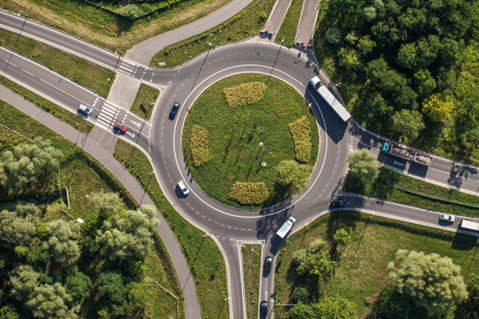Roundabouts—what’s all this about?

Cars entering a roundabout, Jan 10, 2022. (Photo/SafeRoadsUSA)
April 1, 2023
Feb 23, 20223, 11:59 p.m. EST, Erie Pa. —When driving in the US, most motorists expect to see a stop sign or stop light when they arrive at an intersection. But recently, many US drivers have found themselves coming to intersections at which they must yield, slowly enter a circular traffic pattern, careen around the circle, and finally exit out in whichever direction they wish to continue. This circular traffic pattern is called a roundabout.
The first modern roundabout in the U.S. was introduced in the 1990s in Nevada, and today there are more than 9,000 of them dispersed throughout the nation.
Over these past 30 years, the number of roundabouts in the United States have increased, but has this decreased or increased safety for drivers and pedestrians? And are roundabouts any better than an average stop light?
Roundabouts are not only a cheaper alternative to traffic lights, but they are abundantly safer as well.
The design of the modern roundabout was engineered to help improve the flow of traffic. According to HERE360, roundabouts have reduced major delays up to 89% and the stoppage of traffic up to 56%.
Monetarily, roundabouts, according to the Florida Department of Transportation (FDOT) are exceptionally cheaper than a traffic light due to the minimal yearly maintenance needed to upkeep them. Roundabouts can also” help improve sales at nearby businesses across the country as more people can walk or easily drive to locations compared to traditional intersections.”
Driver safety is always a topic of discussion when it comes to new roadways and traffic patterns. Roundabouts are a solution to the stress and anxiety that some intersections can ignite with all the lights and signal-age that may be confusing for even the most seasoned of drivers.
Nowadays roundabouts are centered around a geometric design that allows and forces traffic to slow down, creating a much safer flow of traffic. They also include an innovation from the British in the 1960s, which is the rule that people already in the circle get the right of way.
FDOT states that roundabouts have decreased the number of fatalities in motor crashes and are significantly safer for beginner and elderly drivers than most traditional intersections.
HERE360 also reports that roundabouts have a 37% reduction in collisions, and a 90% decrease in fatalities compared to the average stop light.
Roundabout safety is not only being questioned by motorists, but by pedestrians and cyclists as well.
In cities of all sizes, the ability to comfortably take a casual stroll, ride, or the ability to reach public transportation is necessary and there are various safety measures in place that make roundabouts comfortable and easy for pedestrians to navigate.
For example, according to the American Society of Civil Engineers (ASCE), the narrow circular traffic pattern of the roundabout forces vehicles to move at much slower speeds, giving drivers the ability to have better reaction times when encountering pedestrians.

Despite the many traffic benefits of roundabouts, they still face much opposition from American drivers and pedestrians alike.
The major qualm about the roundabouts for drivers is that they are too stressful and complex to maneuver, especially if the roundabout contains more than one lane.
But, as emphasized by the ASCE, the idea is to have an easy, stress free, and stop free intersection that cuts down on the number of vehicular fatalities simultaneously.
For the average American pedestrian, roundabouts are said to be extremely difficult to safely navigate. Between the cramped landscapes and bad drivers, many pedestrians say that they do not feel as safe walking in or around a roundabout as they do an average stop light.
According to StreetsBlog USA, traffic engineers have designed roundabouts to have accessible pedestrian crossings that give pedestrians and cyclists the ability to safely and efficiently navigate the roundabout.
It is also worthwhile to note that in most states, it is written law that motorized vehicles must yield to pedestrians at crosswalks. Some roundabout designers even go as far to have “yield to pedestrians” signs at each pedestrian crossing.
Overall, the addition of more roundabouts across the US is a definite certainty.

“Roundabouts save lives. They reduce severe crashes, move traffic more efficiently, and are cheaper to maintain than signalized
intersections,” said Ohio Department of Transportation Director (ODOT) Jack Marchbanks on the official Governor of Ohio website.
Roundabouts in the United States have become a huge topic of conversation, as they continue to pop up all around the country, with their safety and efficiency being at the forefront. There are many concerns and false narratives surrounding their presence here in the U.S. and whether they will eventually become as common as in European streets. Only time will tell. But one thing stands true: the modern roundabout is here to stay.





Scott Batson, PE • Apr 4, 2023 at 12:10 pm
Excellent overview of the topic.